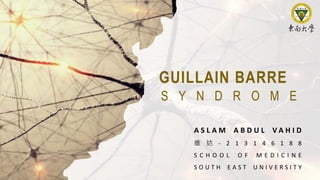Guillain barre syndrome (Short Lecture by Dr Aslam)
- 1. S Y N D R O M E GUILLAIN BARRE A S L A M A B D U L V A H I D ń╗┤ ĶŠŠ - 2 1 3 1 4 6 1 8 8 S C H O O L O F M E D I C I N E S O U T H E A S T U N I V E R S I T Y
- 2. LEARNING OBJECTIVES ETIOLOGY & PATHOGENESIS CLINICAL SYMPTOMS & SIGNS DIAGNOSIS OF GBS DIFFERENTIAL DIAGNOSIS OF GBS MANAGEMENT & PROGNOSIS
- 3. W H A T I S G B S ? ŌĆó It is an acute or subacute onset of generally symmetrical and progressive lower motorneurons paralysis of limbs. ŌĆó A disease which rapidly damages peripheral nerves. ŌĆó May hinder movement, sensation or organ function depending on which nerves are involved ŌĆó Named after French neurologists Georges Gullain and Jean Alexandre Barre-1916
- 4. ŌĆó Often the cause of GBS is unknown ŌĆó Often follows GI infection with diarrhoea or respiratory infection ŌĆó The GI infection due C.jejuni often precedes to GBS ŌĆó It occurs in all parts of the world and in all seasons, affecting children and adults of allages and both sexes. ŌĆó Rare ŌĆō only 1 -2 cases per 100,000 people world-wide each year ŌĆó Most common cause of sudden onset flaccid paralysis E T I O L O G Y
- 5. C L I N I C A L M A N I F E S T A T O N 1.Muscle weakness and Flaccid paralysis - In 25% of patients this weakness affect the respiratory muscle causes respiratory inadequacy 2. Possible Respiaratory Failure 3. ANS Dysfunction - Urinary Retention - Flushing of the face - Cardiac arrythmia- - Orthostatic Hypotension 4. May or may not experience pain -Pain most commonly in Back, Shoulders and Thighs
- 6. 2 main subtypes 1. AIDP-ACUTE INFLAMATORY DEMYELINATING POLYNEUROPATHY 2. AMAN-ACUTE MOTOR AXONAL NEUROPATHY P A T H O P H Y S I O L O G Y
- 8. A M A N ACUTE MOTOR AXONAL NEUROPATHY
- 11. ŌĆó Symptoms are symmetrical ŌĆó progressive weakness of more than one limb ŌĆó Absent reflex/hyporeflexia ŌĆó High levels of proteins in CSF (>0.55g/L) ŌĆó < 10 WBC per mm 3 in CSF ŌĆó Neurophysiological studies ŌĆó Nerve Conduction Study(NCS)- decreased conduction velocities ŌĆó Electromyography(EMG)- decreased muscle recruitments D I A G N O S I S
- 12. ŌĆó Plasmapheresis (Plasma Exchange) ŌĆó Immunoglobulin (IV) ŌĆó Corticosteroids are not given ŌĆó Mechanical Ventilation ŌĆó IV antibiotics therapy ŌĆó Manual movement of limbs ŌĆó Anticoagulent therapy ŌĆō to prevent DVT ŌĆó Physical and Occupational therapy ŌĆó Pshychological therapy T R E A T M E N T
- 13. ŌĆó 2-5% OF GBS patients die o Respiratory paralysis o Cardiac arrest ŌĆó Most patients have a full recovery ŌĆó 30% of patients ŌĆō residual weakness after 3 years ŌĆó 3% of patient ŌĆō weakness and tingling after many years P R O G N O S I S
- 14. ŌĆó Peripheral neuropathy associated with GBS comes on with a sudden onset. ŌĆó Syndrome is autoimmune ŌĆó Demyelinating ŌĆó Ascending ŌĆó Symmetrical condition ŌĆó Affect both sensory & motor neuron ŌĆó Symptoms include parasthesis, absent of reflexes, pain, muscle weakness, may progress to ’āĀ possible respiratory paralysis S U M M A R Y
- 15. ŌĆó ANS dysfunction (Arrhythmia, Orthostatic hypotension) ŌĆó Medical emergency ŌĆó Findings that support positive diagnosis of GBS o Sensory & Motor symptoms o CSF ŌĆō high level of protein, low level of WBC ŌĆó Neurophysiological studies like NCS, EMG ŌĆó Treatment: Plasmapheresis, Immunoglobulin, Antibiotics & Anti-coagulant therapy S U M M A R Y















